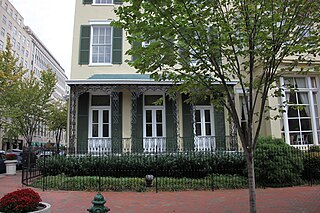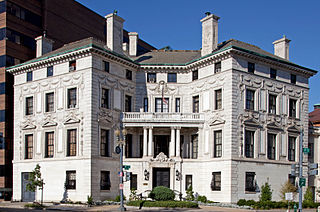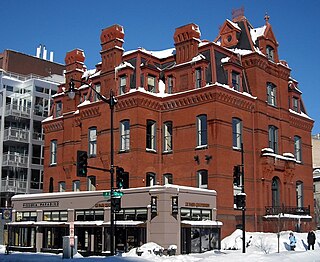
Dupont Circle is a traffic circle, park, neighborhood, and historic district in Northwest Washington, D.C. The Dupont Circle neighborhood is bounded approximately by 16th Street NW to the east, 22nd Street NW to the west, M Street NW to the south, and Florida Avenue NW to the north. Much of the neighborhood is listed on the National Register of Historic Places. However, the local government Advisory Neighborhood Commission and the Dupont Circle Historic District have slightly different boundaries.

Sagamore Hill was the home of the 26th president of the United States, Theodore Roosevelt, from 1885 until his death in 1919. It is located in Cove Neck, New York, near Oyster Bay on the North Shore of Long Island, 25 miles (40 km) east of Manhattan. It is now the Sagamore Hill National Historic Site, which includes the Theodore Roosevelt Museum in a later building on the grounds.

Embassy Row is the informal name for a section of Northwest Washington, D.C. with a high concentration of embassies, diplomatic missions, and diplomatic residences. It spans Massachusetts Avenue N.W. between 18th and 35th street, bounded by Scott Circle to the south and the United States Naval Observatory to the north; the term is often applied to nearby streets and neighborhoods that also host diplomatic buildings, such as Kalorama.

Carrère and Hastings, the firm of John Merven Carrère and Thomas Hastings, was one of the outstanding American Beaux-Arts architecture firms. Located in New York City, the firm practiced from 1885 until 1929, although Carrère died in an automobile accident in 1911.

The Cosmos Club is a 501(c)(7) private social club in Washington, D.C. that was founded by John Wesley Powell in 1878 as a gentlemen's club for those interested in science. Among its stated goals is, "The advancement of its members in science, literature, and art and also their mutual improvement by social intercourse."

Whitehall is a 75-room, 100,000 square foot Gilded Age mansion open to the public in Palm Beach, Florida in the United States. Completed in 1902, it is a major example of neoclassical Beaux Arts architecture designed by Carrère and Hastings for Henry Flagler, a leading captain of industry in the late 19th century, and a leading developer of Florida as a tourist destination. The building is listed a National Historic Landmark. It now houses the Henry Morrison Flagler Museum, named after its builder.

The Oaks House Museum, also known as The Oaks, located at 823 North Jefferson Street in Jackson, Mississippi, is the former home of Jackson Mayor James H. Boyd (1809–77) and his wife Eliza Ellis Boyd and their family. Having survived the burning of Jackson during the Civil War, The Oaks is one of the oldest structures in the city. It is listed on the National Register of Historic Places and is a Mississippi Landmark.

Isaac Daniel Roosevelt was an American businessman and the paternal grandfather of U.S. President Franklin D. Roosevelt.

Vernon Court is an American Renaissance mansion designed by architects Carrère and Hastings. It is located at 492 Bellevue Avenue, Newport, Rhode Island, on the Atlantic coast of the United States. The design is loosely based on that of an 18th-century French mansion, Château d'Haroué.

Arden is a historic estate outside Harriman, New York, that was owned by railroad magnate Edward Henry Harriman and his wife, Mary Averell Harriman. By the early 1900s, the family owned 40,000 acres in the area, half of it comprising the Arden Estate. The main house is at the top of a mountain east of the village, reachable by Arden House Road from NY 17. Since 2011, it has been owned by the nonprofit Research Center on Natural Conservation, which operates Arden House as a conference center with 97 guest rooms.

Jackson Place is a Washington, D.C. street located across from the White House and forming the western border of Lafayette Square between Pennsylvania Avenue and H Street, NW, beginning just south of Connecticut Avenue.

The Administration Building, Carnegie Institute of Washington is a Beaux-Arts style building designed by architects Carrere and Hastings, and located at 1530 P Street NW in Washington, D.C. It houses the Carnegie Institution for Science, a philanthropic scientific research organization founded in 1902 by Andrew Carnegie. In recognition of the building's architecture and its unique tenant, the building was declared a National Historic Landmark in 1965. The building was also designated a contributing property to the Sixteenth Street Historic District in 1978.

The Sixteenth Street Historic District is a 1.25 mile (2.01 km) linear historic district in Washington, D.C., that includes all structures along 16th Street NW between H Street and Florida Avenue. The district's southern boundary is bordered by Lafayette Square, just north of the White House, and Meridian Hill Park on its northern boundary. It includes an eclectic mix of architectural styles on one of the city's most historic and important numbered streets including single and multi-family residential buildings, embassies, hotels, churches, and office buildings. Most of the district's oldest structures are religious and residential buildings, while many of the commercial buildings were built in the early to mid-20th century. The stretch of 16th Street between Scott Circle and Florida Avenue was recognized as a historic district in 1978 and listed on the National Register of Historic Places, and in 2007 it was expanded to include buildings south of Scott Circle to H Street. The historic district is also listed on the District of Columbia Inventory of Historic Sites.

The Sulgrave Club is a private women's club located at 1801 Massachusetts Avenue NW on the east side of Dupont Circle in Washington, D.C. The clubhouse is the former Beaux-Arts mansion on Embassy Row built for Herbert and Martha Blow Wadsworth and designed by noted architect George Cary. During World War I the Wadsworth House was used as the local headquarters for the American Red Cross.

The Cutts–Madison House is an American colonial-style historic home, now used for offices located at 1520 H Street NW in Washington, D.C. The house is best known for being the residence of former First Lady Dolley Madison, who lived there from November 1837 until her death in July 1849.

The Benjamin Ogle Tayloe House is a Federal-style house located at 21 Madison Place NW in Washington, D.C., in the United States. The house is on the northeast corner of Madison Place NW and Pennsylvania Avenue NW, directly across the street from the White House and the Treasury Building. Built in 1828 by Benjamin Ogle Tayloe, son of Colonel John Tayloe III, the house became a salon for politically powerful people in the federal government.

The Patterson Mansion is a historic Neoclassical-style mansion located at 15 Dupont Circle NW in Washington, D.C., in the United States. It was built by Robert Wilson Patterson, editor of the Chicago Tribune newspaper, and used by him and his family for entertaining when he was in the city. Completed in 1903, it was deeded to the American Red Cross in 1948. The Red Cross sold it to the Washington Club in 1951. The structure was renovated and a small, two-story addition added in 1955. As of December 2013, the property was up for sale after plans to convert it into a boutique hotel fell through. In June 2014, the Washington Club sold the Mansion for $20 Million to developer SB-Urban. The Washington Club sold the property because "it is disbanding and no longer needs the space, according to John Matteo, an attorney at Jackson & Campbell, who represented the club in the sale."

The James G. Blaine Mansion, commonly known as the Blaine Mansion, is an historic house located at 2000 Massachusetts Avenue NW, in the Dupont Circle neighborhood of Washington, D.C. The imposing house was completed in 1882 for James G. Blaine, a Republican politician from Maine who served as Speaker of the House, and later as a US Senator and US Secretary of State. He was also a presidential candidate who was narrowly defeated by Grover Cleveland in the 1884 United States presidential election.

Whittemore House is an historic building located at 1526 New Hampshire Avenue, N.W., in the Dupont Circle neighborhood of Washington, D.C. The former private residence, whose previous occupants include a musician, several politicians, and a mountain explorer, now serves as a historic house museum and headquarters of the Woman's National Democratic Club (WNDC).

Juniper Hill Farm, also known historically as Juniper Hill Inn and the Maxwell Evarts House, is a historic estate and mansion house on Juniper Hill Road in Windsor, Vermont. Built in 1902 by Maxwell Evarts, it is a large and elaborate example of Colonial Revival architecture. Evarts was a prominent New York lawyer, who played host to two presidents of the United States here. The property has seen a variety of commercial uses since the death of Evarts' son in 1936. In 2016, it reopened as the Windsor Mansion Inn with new owners. It was listed on the National Register of Historic Places in 1988.





















